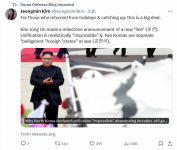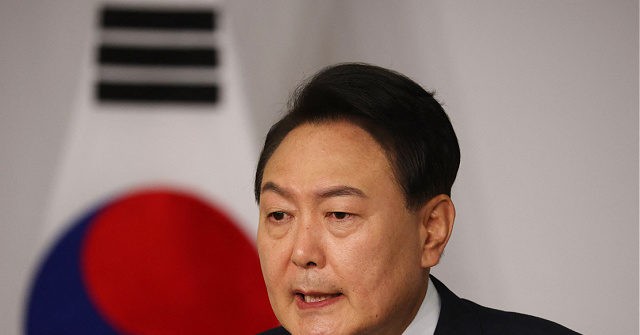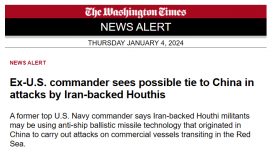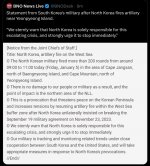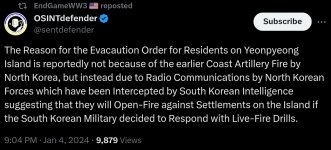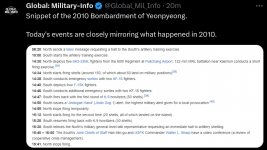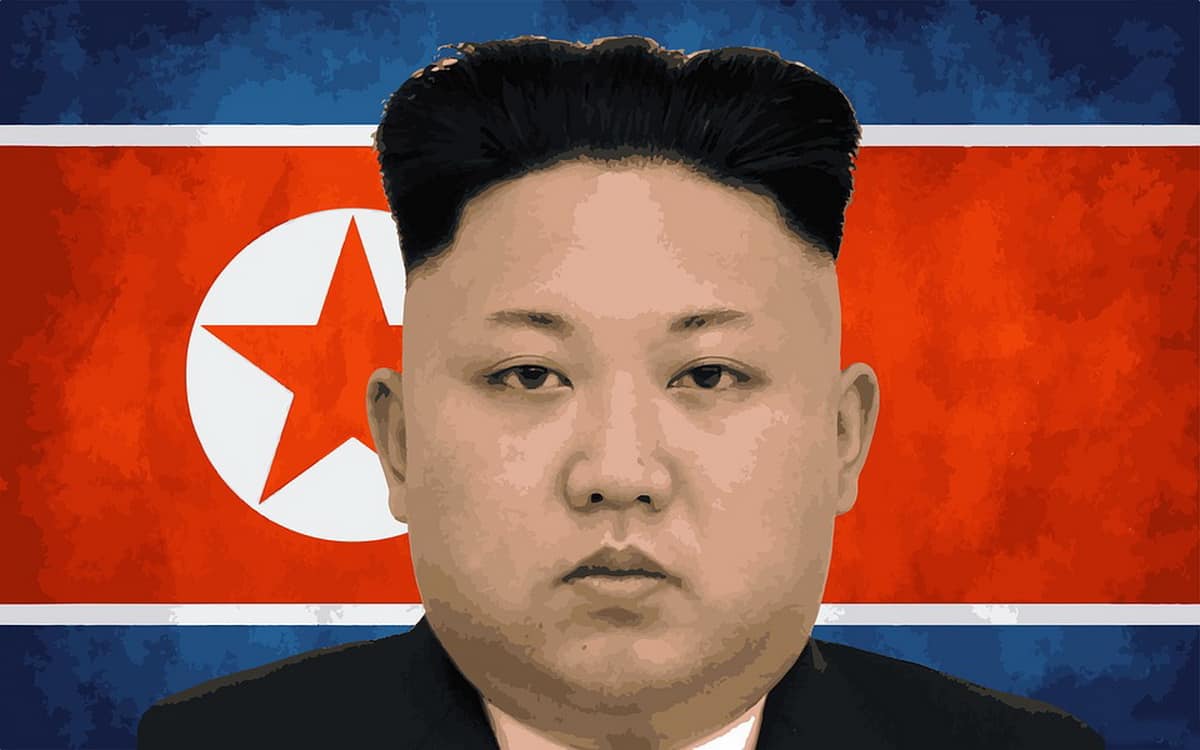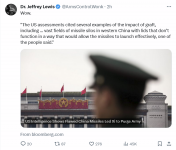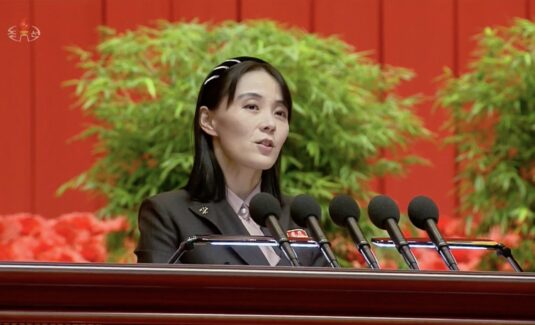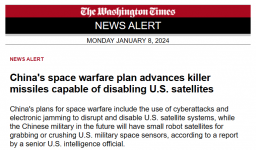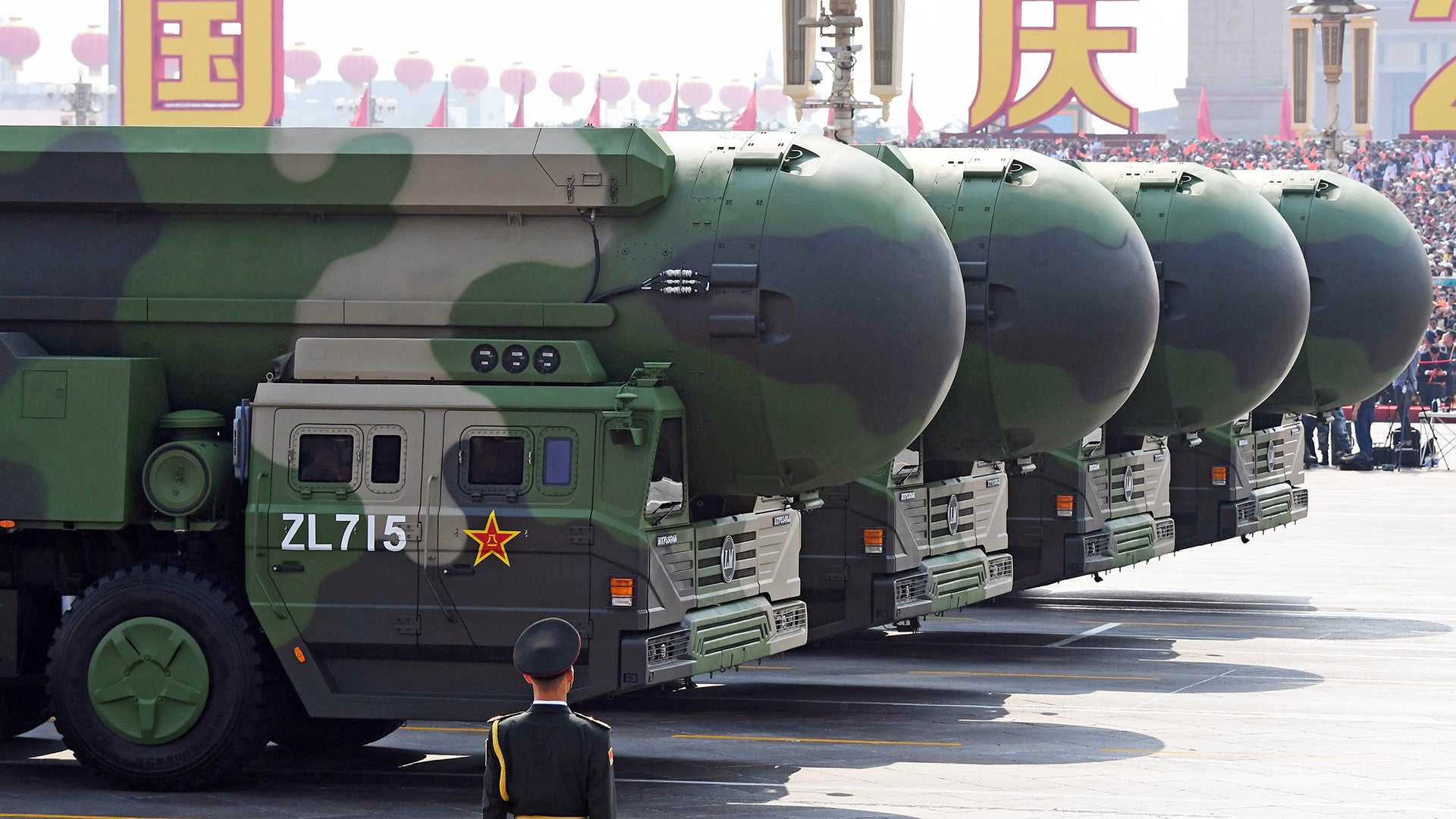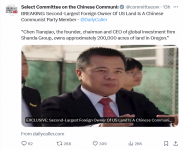thedrive.com

Water-Filled Missiles, Silo Problems Behind China Purge: Report
Joseph Trevithick
Missiles filled with water instead of fuel and lids on silos that do not work properly were among the factors that led to the sacking of China's defense minister and a slew of other senior officials last year, according to a recent report. These issues, blamed primarily on corruption, have in turn reportedly rattled Chinese President Xi Jinping's confidence in his country's armed forces, including its ability to conduct major operations,
such as an invasion of Taiwan. It also raises questions about the readiness of China's military and
its broader modernization efforts.
Chinese road-mobile DF-41 intercontinental ballistic missiles (ICBM) on parade.
Kyodo via AP
"The U.S. assessments cited several examples of the impact of graft, including missiles filled with water instead of fuel and vast fields of
missile silos in western China with lids that don’t function in a way that would allow the missiles to launch effectively, one of the people said," according to
Bloomberg's report.
Bloomberg did not identify the missiles in question or say how many silos were found to have improperly functioning lids. The outlet also said it could not independently verify these assessments, and that it received no further details on the record from either the White House or the Pentagon.
Based on the limited information from the
Bloomberg story, one immediate possibility regarding the water-filled missiles is that this might have to do with Chinese liquid-fueled ballistic missiles. The PLARF currently has a relatively small arsenal of silo-based, nuclear-armed liquid-fueled
DF-5-series intercontinental ballistic missiles (IBCM). In the late 2010s, at least one brigade of older road-mobile liquid-fueled
DF-4 IBCMs was also still operational, though independent experts assess those weapons
to have finally been retired.
However, China's DF-5s are not understood to be kept in a fueled state by default. Liquid rocket fuel is
very toxic and corrosive, in addition to being flammable and explosive. Though
there are ways to
mitigate these issues, this all typically makes it dangerous to keep liquid-fueled missiles fully loaded with propellant for extended periods of time. It's also one of the reasons why missiles with solid fuel rocket motors
are more flexible, since they do not need to be fueled beforehand, and are generally safer overall to handle. It reportedly takes
an average of 30 to 60 minutes to fuel an empty DF-5.
All of this, in turn, raises questions about when PLARF DF-5s might have been filled with water and how this was discovered. There is the possibility that they were found to have significant residual water in their tanks after defueling following training exercises or inspections, which might lead to issues when fueling them in the future.
There is also the possibility that the water may have actually been present in subcomponents on DF-5s or other Chinese ballistic missiles that are unrelated to their main rocket motors, such as post-boost vehicles. Post-boost vehicles around found on ballistic missiles (typically ICBMs) with multiple warhead configurations, also known as multiple independently targetable reentry vehicle (MIRV) designs. On MIRVed missiles, the post-boost vehicle releases individual warheads over their targets, as you can read more about
here. Thrusters that use liquid propellants are generally used to orient the post-vehicle vehicle as it travels outside of the Earth's atmosphere.
The thread below from user
@LIM49Spartan on X, formerly, Twitter, runs down one potential scenario for how Chinese missiles might have ended up with water-filled post-boost vehicles.
There is also the possibility that what was found to be full of water were tanks intended to hold fuel that would go into DF-5s before launch, not the missiles themselves. The reportedly water-filled missiles may have nothing to do with the PLARF's ballistic missile inventory, too.
"The report doesn’t ... specify what types of missiles are implicated. I’d note, for example, that the PLARF operates 300+
cruise missiles, which are mostly liquid-fueled," Masao Dahlgren, a fellow
with the Missile Defense Project at the
Center for Strategic and International Studies (CSIS) think tank, pointed out to
The War Zone. Cruise missiles are powered by air-breathing jet engines that use jet fuel.
Launchers for China's DF-100 ground-launched supersonic land attack cruise missile on parade.
AP Photo/Mark Schiefelbein
On a broader level, the "watering down or even fully replacing fuel with water is
a common form of military corruption
around the world," Dr. Jeffrey Lewis, a member of the staff at the James Martin Center for Nonproliferation Studies (CNS) at the Middlebury Institute of International Studie and Monterey and a member of the U.S. State Department's International Security Advisory Board, told
The War Zone. "This allows the corrupt individual to sell the fuel on the black market for a profit."
Bloomberg's report has similarly few details about the silo lid issues. Two years ago it emerged that the PLA had embarked on a massive effort to expand its silo-based ICBM capacity
by roughly a factor of 10.
"Owing to the 'crash program' nature of early US silo construction, there were many design and construction problems for
the Titan [ICBM] silos," Dr. Lewis also said. "It's easy to imagine how natural difficulties faced in a rapid project of construction might be exacerbated by corruption."
The Pentagon's most recent annual report on Chinese military and security developments,
released in October 2023, said that U.S. intelligence assessed
that DF-31-series solid-fuel ICBMs
had been loaded into at least some of these news silos. There have been discussions in the past about the possibility of a silo-based version of
the newer DF-41, another solid-fuel design, too. There had also been indications that some of China's new silos might remain empty deliberately as part of a so-called "shell game" strategy to complicate enemy targeting processes, as you can read more about
here.
Satellite imagery included in the Pentagon's last annual China report released last year showing what appears to be the completion of work, at least externally, on a new ICBM silo in a field in northwestern China. The lid of the silo is just visible at the center of the image from February 2023.
DOD
It's also worth noting that the Pentagon has assessed in recent years that China's silo expansion is part of a larger push on the country's part to adopt a
so-called Launch on Warning (LOW) deterrence posture. This means the PLARF would be ready to launch a retaliatory nuclear strike following the detection of an inbound strike, but before any of those incoming warheads hit their targets.
There is a possibility that the discovery of water-filled missiles (if they were indeed ICBMs) and issues with silo lids are tied, at least in part, to the LOW shift and reflect challenges the PLARF has faced in adopting that kind of deterrent posture in a relatively short amount of time.
The time it takes to prepare DF-5s for launch would make them less suitable to support a LOW posture, to begin with. Major changes to how those missiles are fueled and defueled on a regular basis, and the ability of PLARF units to perform those tasks after years of being in lower states of readiness, might contribute to the issues in the assessments
Bloomberg reported on.
When it comes to silos, these are complex and largely underground structures. Just building more than 100 of them, especially in remote desert areas, along with the required supporting infrastructure, is a hugely complicated and resource-intensive undertaking.
Another satellite image included in last year's U.S. military China report showing a garrison within the new silo fields in Guazhou. This is another indication that these fields are closer to becoming operational, at least to some degree, if they aren't already.
DOD
"It is important to caution that we don’t know how widespread these defects are," Hans Kristensen, the Director of the Nuclear Information Project at the Federation of American Scientists (FAS) think tank, told
The War Zone. "Are they systemic and affect all new silos or only some? Nor do the defects change the fact that China is engaged in a
significant increase of its nuclear forces."
What is not up for debate is that there has been a major upheaval within the PLARF and other entities linked to it, as well as China's defense establishment at large, in the last year or so. In June 2023, Li Yuchao, then head of the PLARF, as well as the force's top commissar and two of Li's deputies, were
all dismissed, reportedly over corruption. In July, Wu Guohua, a former senior PLARF officer and head of the PLA's
Third Department intelligence directorate, died
under mysterious circumstances.
Then, in September 2023, China's Defense Minister, Li Shangfu,
disappeared from public view, officially due to an unspecified illness. The following month, Chinese authorities
formally announced that Li, who is reportedly under investigation for corruption, had been sacked. He had only been at that post for seven months after taking over for Wei Fenghe in March of last year. Wei, another former PLARF commander, does not appear to
have been publicly heard from since then.
Newly elected Chinese Defense Minister Gen. Li Shangfu takes his oath during a session of China's National People's Congress (NPC) at the Great Hall of the People in Beijing on March 12, 2023.
AP Photo/Andy Wong
"In the latest round on Dec. 29, China’s top legislative body unseated nine defense figures, including five linked to the missile force and at least two from the Equipment Development Department, which is charged with arming the military,"
Bloomberg reported over the weekend. "Days earlier, China’s main political advisory body publicly removed three executives from state-owned missile manufacturers."
"Those are just the removals Beijing has made public,"
Bloomberg's story added. "Unlike other parts of the Chinese system, the military doesn’t announce its corruption investigations. Another Rocket Force major-general was quietly removed from Beijing’s municipal legislature in November, Chinese news outlet
Caixin reported."
"The new head of the Rocket Force is an outsider – an Admiral from the Navy – which suggests the issue was corruption that went very deep down the chain of command," the Middlebury Institute's Dr. Lewis pointed out to
The War Zone.
Of course, ostensible anti-corruption efforts have been a hallmark of Chinese President Xi's regime since he assumed that role in 2013 and there has been a notable uptick in this activity in recent years.
"In 2022, General Secretary Xi delivered a speech to the CCP [Chinese Communist Party] Central Commission for Discipline Inspection in which he stated that although serious potential dangers of corruption within the Party and the military have been rooted out, the fight against corruption is still raging in the PRC," the Pentagon's most recent China report from last year notes. "In mid-2023, PRC [People's Republic of China] media announced that PLA Rocket Force leadership was being replaced and the PLA launched an inquiry into corruption linked to the procurement of military equipment, indicating that the PLA’s anti-corruption campaign remains incomplete."
The issues surrounding the PLARF have reportedly had a more serious impact on Xi's decision-making, especially around major military actions in the near term, according to U.S. intelligence cited in the
Bloomberg report.
"The U.S. assesses that corruption within the People’s Liberation Army has led to an erosion of confidence in its overall capabilities, particularly when it comes to the Rocket Force, and also set back some of Xi’s top modernization priorities," according to
Bloomberg. "At the same time, the U.S. assesses that Xi hasn’t been weakened by the widening purge ... Rather, they said, his move to oust senior figures – including some promoted under his watch – shows his hold over the Communist Party remains firm and that he’s serious about improving discipline, eliminating corruption and ultimately preparing China’s military for combat over the long term."
 )
)
